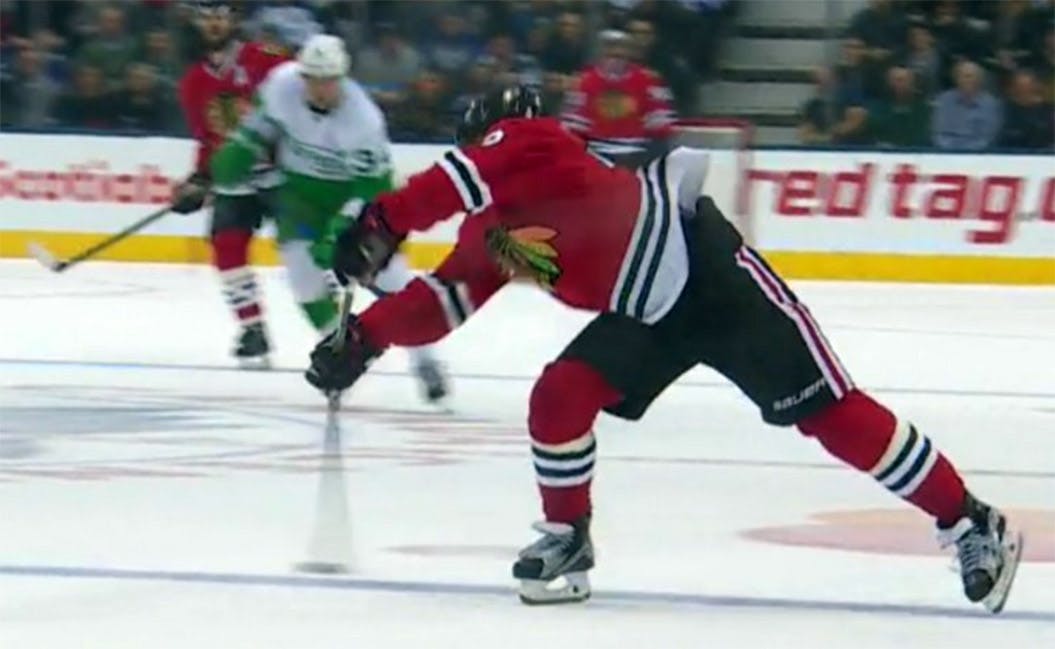Two moments that could’ve changed the course of OT

Last night, the Toronto Map.. err, St. Pats lost a heartbreaking game in overtime against the Chicago Blackhawks. It was one that was close throughout, that could have realistically gone either way. Today’s gripe is not to say that this was a game they absolutely should have won, nor is it to say that some sort of fix was in by any means. Ultimately, the things I’m about to bring up are closer to the borderline scale of calls and are the type margin of error decisions that are hard for any referee to make. But there might be something to the both of them anyway.
Too Many Men
A little over a minute into the first minute of overtime, the Chicago Blackhawks had too many men on the ice. Patrick Kane waves his stick to call for a pass from Artemi Panarin, who dishes it to him. Richard Panik, on the other hand, believes that Kane has called for a change, and hops onto the ice to take his place. Realizing his mistake, he comes back off, with nobody the wiser.
Except for everyone on the broadcast, and even the league, who lists the line change, and then gives the remainder of the ice time on the shift after Panik goes back off to Marcus Kruger.

It’s a really odd sequence of events. Kane has possession of the puck while their are four players active on the ice, with nobody in the process of getting off, which is a clear violation of the league rules. While some leniency is usually given (for example, they aren’t hard and fast about changing players being 5 feet from the bench before their replacements come on), this was a clear cut case of an extra player coming on to replace no-one. Was it an accident? Absolutely. Did it make an impact on the play? No. Should it have been called? Yes. It’s the antithesis of this call that you might remember from the centennial classic, where the Leafs were penalized for possession the puck while William Nylander was halfway onto the bench while coming off.
The Hawks didn’t score on this shift, but a Toronto powerplay could have made a hell of a difference. There is a sequence a few seconds after this one that Chicago fans have pointed out to be questionable on the Leafs’ part as well, and they have a semi-legitimate case there, though that leans closer to the subjectivity of 5 feet than anything, as the Leafs were back to three men well before ever having possession or making a tangible play.
The Game Winner
Ryan Hartman scored Chicago’s game-winning goal with about twenty seconds remaining in overtime, sending everybody into a bit of a frenzy. Most notably, it was believed that Artemi Panarin was offside when he initiated the pass to Hartman. Take a look at this freeze frame from when the puck begins to take motion off his stick:

Rory Boylen of Rogers Sportsnet was quick to rule off the idea of any sort of funny business here, Insisting that the play was legitimate according to rule 83.1 on off-sides. Here’s what he cities:
The debate, though, began after it appeared Panarin passed the puck before it hit the blue line, therefore “losing” possession of it and making him offside. However, there is a line under NHL Rule 83.1 that seems to allow this play, provided Panarin had control of the puck when his skates crossed the line, which he clearly did.The rule reads:“However, a player actually controlling the puck who shall cross the line ahead of the puck shall not be considered ‘off-side,’ provided he had possession and control of the puck prior to his skates crossing the blue line.”
This, however, doesn’t touch on the next paragraph of 83.1, which is actually relevant to the conversation here.
It should be noted that while the position of the player’s skates is what determines whether a player is “off-side,” nevertheless the question of an “off-side” never arises until the puck has completely crossed the leading edge of the blue line at which time the decision is to be made.
Panarin is welcome to carry the puck in behind him, but for this play to be on-side, he needs to have control of the puck while it’s completely in the blue. And, well….

I don’t see it. The frame before shows the puck not even on the blue line at all and my interpretation of that one is that he’s already released it, but at this point, you can definitely see his stick has height above the puck and that it’s in motion to Hartman.
Purely interpreting the rules as they, Panarin hasn’t completely made his move yet, and doesn’t possess the puck when it completely crosses the leading edge of the blue line. The league reviewed it, and Mike Babcock said he was okay with it (not that a fine would have helped him much, to be fair), but it seems like this should have been called off.
What does this all mean?
I don’t believe the Leafs got jobbed by any means. Being honest about both plays, Panik made zero impact on the flow of the game in his too-many-men situation, and an inch wasn’t going to stop Hartman from scoring that goal, nor would it have led Jake Gardiner to intercepting the pass. Both plays made no impact on the game, and as someone who wouldn’t be against abolishing offsides, the last one, in particular, is something I’m not a huge fan of arguing about.
If Toronto wanted to win this game, they should’ve scored more goals than the Blackhawks. Refereeing is pretty much the last place where I’d point my fingers for the end result of this one. But if either of these tougher calls in big went in Toronto’s favour instead of Chicago’s, who knows what could have happened. At a stage in the season where standings points are being counted desperately, having what-ifs like this is just a little nervewracking.
Recent articles from Jeff Veillette




